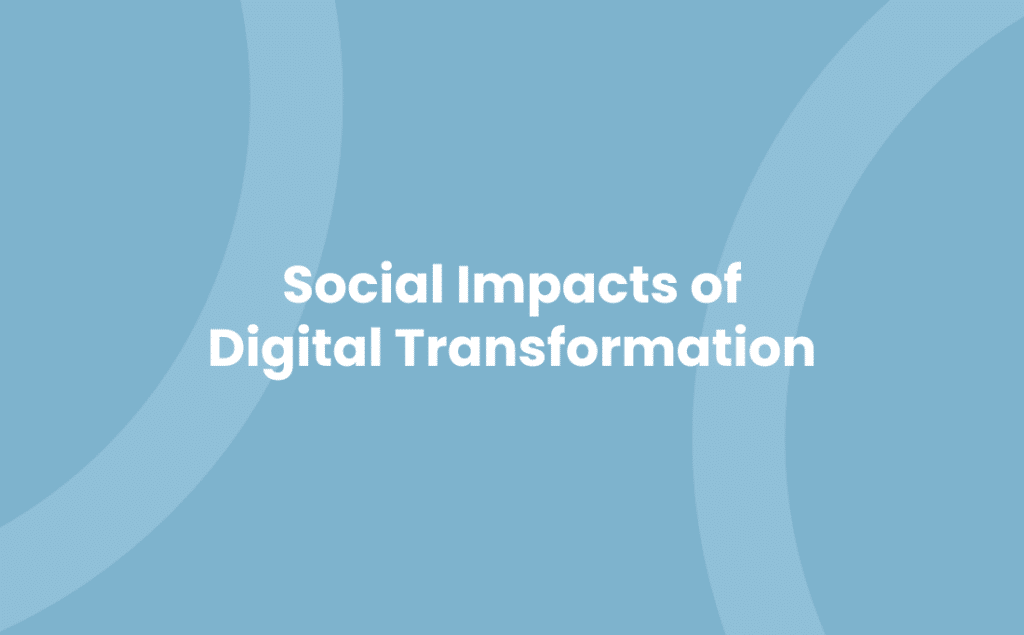You’re living in the digital era, where innovation is the new normal and technology is transforming every aspect of our lives. But have you ever stopped to consider the social impact of this digital transformation? It’s a topic that’s sparking debates and discussions worldwide.
From how we work, learn, and interact, to the very fabric of our societies, digital transformation is reshaping our world. But what does this mean for you, your community, and the wider society? In this article, we’ll delve into the social implications of digital transformation, exploring its benefits, challenges, and the ways it’s redefining our future. So, let’s embark on this digital journey together to understand its social footprint better.
Understanding Digital Transformation
To make good with the idea of digital transformation, one must appreciate its foundation. Digital transformation, at its core, revolves around the integration of digital technology into all areas of an organisation. It’s a comprehensive reshaping process that alters how businesses operate and offer value to their clients.
There’s a radical focus on enhancing the overall user experience through the innovative use of technologies. Whether it’s automating a lengthy manual process, adapting to new business tactics, or going beyond the confines of conventional practices, digital transformation aims to improve efficiency and agility. But remember, it’s not just about getting the latest tech. Rather, it involves a cultural shift that pushes organisations to consistently challenge the status quo, experiment and adapt to failures.
You might consider digital transformation as a long term strategy, one that builds upon itself year after year. It constantly evolves in response to the latest technological trends, consumer behaviour, and data insights. The force of digital transformation necessitates a rethink of the traditional business model. Consequently, it can reinvent roles and tasks, operations, as well as interaction with customers.
The digital transformation social impact embodies a colossal change. It’s not just businesses that are feeling the shift, but society as a whole is getting swept in this digital tide. Let’s face it, every aspect of life is becoming increasingly digitised. In the following sections, we delve deeply into the social implications of this sweeping change, unravelling the pros and cons of a digitally-led life.
In unpacking the ‘how’, ‘why’, and ‘what’ of digital transformation, you’ll gain an understanding of the monumental role it plays in reshaping life as we know it. Armed with this knowledge, you can seize the advantages offered and mitigate potential repercussions.
Ultimately, understanding digital transformation marks the initial step towards adapting and thriving in the digital era. As the world becomes ever more interconnected and digital, this has become an indispensable understanding for organisations and individuals alike.
Social Dynamics and Digital Transformation
Navigating the realm of digital transformation ensures not only shifts in organisational structures and operations but significant evolution in our societal dynamics as well. This digital transition aims at more than just enhancing efficiency and user experience. It extends a profound and far-reaching social impact that’s continuously influencing our interactions, behaviours, and as a whole, how societies function.
In this digital era, we’re witnessing the birth of brand new societal norms and cultures, underpinned by technology. Let’s delve deeper into understanding how digital transformation impacts our social dynamics, shaping our world in an ever-evolving manner.
- Increased Connectivity and Communication: We’re more connected now than ever, thanks to the digital world. These connections aren’t merely national but global, making the world feel like a small town. Within the realms of social media, online forums and communication tools, digital transformation has facilitated instant interconnections amongst different cultures and communities.
- Information Dissemination and Awareness: Free flow of information, quick access to news from every corner of the world is another fruit of digital transformation. It’s made us part of a more informed and aware society.
- Influencing Behaviour and Trends: Trends used to take years to spread in the past. Now, a hashtag on Twitter or an Instagram post can establish a new trend within hours, influencing behaviours on a global level.
- Empowerment and Advocacy: The digital world is also a platform for individuals and groups to voice their opinions, campaign for change and connect with like-minded individuals. This empowerment stands as a unique face of digital transformation’s social impact.
- Enhanced Services and Experiences: Numerous sectors, ranging from health to education, from shopping to banking, have benefitted from the rise of digitalisation, offering tailored services designed to enhance user experience.
However, with these advancements, come certain challenges. The digital divide, data privacy issues, online bullying, fake news – these are just some of the potential threats that the realm of digital transformation needs to address. But, amidst its trials and complexities, digital transformation continues to drive societal evolution in a way that’s robust, dynamic, and intriguing.
Case Studies on Digital Transformation’s Social Impact
Perusing through specific case studies offers a tangible perspective on the profound effects of digital transformation. It serves to provide practical insights into its societal impacts. Below are such illustrative examples.
- Public Health – The NHS COVID-19 App: A striking instance in the realm of Public Health is the National Health Service’s COVID-19 app in the United Kingdom. This digital tool utilises contact tracing technology, aiming to suppress the transmission rate of the virus. Society benefits by receiving real-time alerts about exposure risk, enabling faster reactions. However, user concerns about data handling and privacy infringements have also emerged.
- Education – Khan Academy: Online learning platforms such as Khan Academy are stellar examples of digital transformation in education. The platform provides quality lessons on a wide range of subjects for free, bridging educational gaps and promoting inclusive learning. Despite its advantages, issues related to internet access inequality and the digital divide pose significant challenges.
- E-commerce – Amazon: The kingpin of e-commerce, Amazon, showcases how digital transformation reshapes shopping behaviour. With millions of products at one’s fingertips, it offers convenience and wide selection choices. On the flip side, it raises concerns about the survival of local businesses and the infamous “Amazon Effect”.
- Financial Services – Monzo: Fintech companies like Monzo provide a fascinating look into digital transformation in the banking sector. They offer app-based banking services that dramatically transform traditional banking practices. While the convenience and efficiency are immense, there are apprehensions about data security and digital financial crimes.
Each of these case studies illuminates how digital transformation leaves a significant imprint on society. They echo the dual-sided effects – potential benefits and accompanying challenges. We mustn’t overlook these societal impacts of digital transformation while grappling with its rapid progression. Addressing the complexities and navigating through its impacts is vital in our increasingly digital society.
The Positive Social Impact of Digital Transformation
Shifting your gaze to the shimmering side of the coin of digital transformation reveals its positive social impact. It’s an avenue where innovation meets connectivity, fostering societal growth with swift changes.
Digital transformation redefines the ways communities function, nurtures greater inclusivity, and propels universal access to knowledge and opportunities. It functions akin to a global equaliser, diminishing the barriers and fostering an inclusive digital society.
In quantifiable terms, digital progression stirs up economic growth. The World Economic Forum estimates that about 60% of the global GDP will be digitised by 2022, escalating the rate of job creation. Jobs in digital sectors, for example, digital marketing, cybersecurity, and software development, have risen by 9% in the UK in recent years. This growth not only ensures increased employment opportunities but also empowers citizens with transferable digital skills.
Embrace the positive effects of digital transformation in education. It proves transformative by expanding reach and allowing remote learning. Digital platforms like Coursera and Khan Academy provide access to global education resources. They fuel knowledge acquisition by providing diverse courses ranging from trade skills to advanced mathematics, thus impacting social well-being.
Lastly, digital transformation inspires improved communication models. People have adopted social platforms like Facebook and WhatsApp for everyday communication. Access to real-time information across borders enhances global awareness, triggers participative action, and nurtures diverse cultural exchanges. The implications are far-reaching, playing a role in emergencies as people are alerted and coordinated swiftly.
This discourse on the positive social impact of digital transformation appreciates the advancements, the expanding digital economy, the global classroom, and the enriched communication channels. It is prudent not to ignore the potential challenges inherent in our digital journey, necessitating a balance between acquiring the positives and curtailing the negatives.
The Negative Social Impact of Digital Transformation
Though digital transformation has brought numerous benefits, several adverse effects make their mark on the societal front. They form part of the digital social impact that needs a thorough assessment for mitigating measures. These negative impacts ultimately add to the complexities of the digital transformation process.
Firstly, the digital divide poses a considerable problem, widening inequalities between demographics with varying access to technology. In essence, those lacking computer literacy or internet access fail to capitalise on the benefits of digital transformation. It inadvertently creates a societal hierarchy based on technological accessibility and skills, culminating in socio-economic disparities.
Secondly, issues related to data privacy surface frequently. Digital platforms are often subject to cyber threats, data breaches, and identity theft. Despite best efforts to secure user data, instances of privacy invasion trigger distrust in the digital tools and fuel further societal anxiety.
Thirdly, digital transformation has unintentionally led to reduced human interaction. In many cases, face-to-face communication is replaced by digital means, diminishing the value of personal interaction and fostering impersonal relationships.
Fourthly, the onslaught of digital information, or ‘information overload,’ can lead to confusion and decision paralysis. With innumerable sources of information available at the touch of a button, distinguishing credible sources becomes a serious challenge.
Additionally, job displacement presents a significant concern. Automation and artificial intelligence might render certain jobs redundant, leading to increased unemployment. This upheaval in job markets necessitates a humongous task of reskilling and upskilling the workforce for the digital economy.
Mitigating these negative social impacts of digital transformation requires strategic planning and robust policies. The key lies in balancing the benefits of digital progression alongside creating safeguards against potential pitfalls. Thus, the journey of digital transformation, while brimming with prospects, also invites rigorous scrutiny for its impacts on our societal fabric.
Strategies for Maximising the Positive Social Impact of Digital Transformation
Embarking on a digital journey can reap many rewards. However, there can also be bumps in the road, spotlighting the digital divide, data privacy concerns, and other issues. Here, we’ll explore key strategies to truly harness the potential of digital transformation, so we are not merely scratching the surface of transforming economic growth, education, and communication models.
Actively Bridge the Digital Divide
Equal access to digital resources enhances societal inclusivity, a crucial positive social impact of digital transformation. Identify regions or groups that experience a digital deficit and devise targeted interventions. For instance, you can offer training programs that boost digital literacy, safe internet usage, and computer skills. Let’s not let connectivity gaps and lack of digital awareness sabotage the potential societal growth that digital transformation promises.
Foster Strong Data Privacy Measures
Handling personal and sensitive data with absolute discretion is paramount. By firming up data protection laws and pushing for their strict implementation, we help ensure that digital transformation doesn’t come at the cost of individual privacy. Education around data security can be as important as a firewall, fostering an aware digital culture.
Enhance Human Interaction with Tech
While technology indeed streamlines processes, it’s essential to remember that it shouldn’t replace human interactions. Instead, digital tools should enhance them. You can propagate the use of technology in a way that it facilitates, not impedes, meaningful human contacts. Chatbots, for instance, answer queries within seconds and provide personalised interactions, preserving human contact in the new digital age.
Balance Information Load
No doubt, digitalisation has made access to knowledge ubiquitous. To prevent information overload, a proper filtration protocol and the careful use of push notifications can guide users to the information directly relevant to them. It’s about working smarter with technology; let technology work for you, not against you.
Adopting these strategies can help tilt the scale towards the positive side of digital transformation’s social impact. The benefits of a digitally progressive society, after all, lie in a balanced blend of technological innovation and strategic foresight.
Conclusion
You’ve seen how digital transformation can be a double-edged sword. On one hand, it’s a catalyst for societal growth, inclusivity, and universal access to knowledge. It’s also a driver for economic growth, revolutionising education, and enhancing communication. Yet, it’s not without its downsides. The digital divide, data privacy issues, reduced human interaction, and job displacement are real concerns.
Navigating this digital journey effectively requires strategic planning and policies. It’s about maximising the benefits and minimising the risks. It’s about bridging the digital divide, bolstering data privacy, fostering human interaction with technology, and managing information overload.
Remember, the power of digital transformation lies in its potential to reshape societies. It’s up to you to make it work for everyone, not just a privileged few. Keep these insights in mind as you navigate your digital journey.


